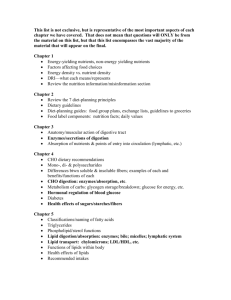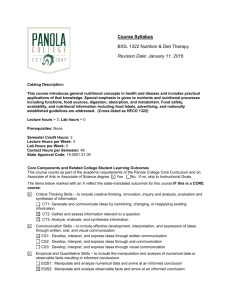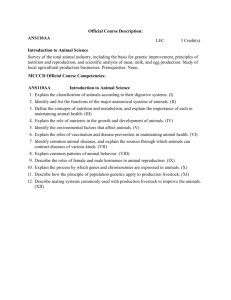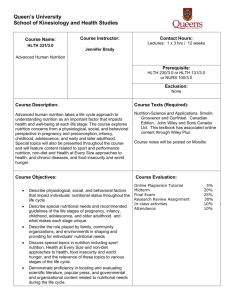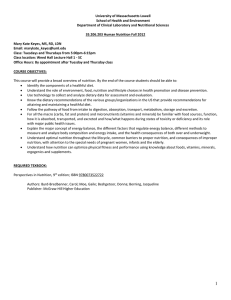Study Guide_Final_Fall 2013_35.206.203 - 35-206-203-f13
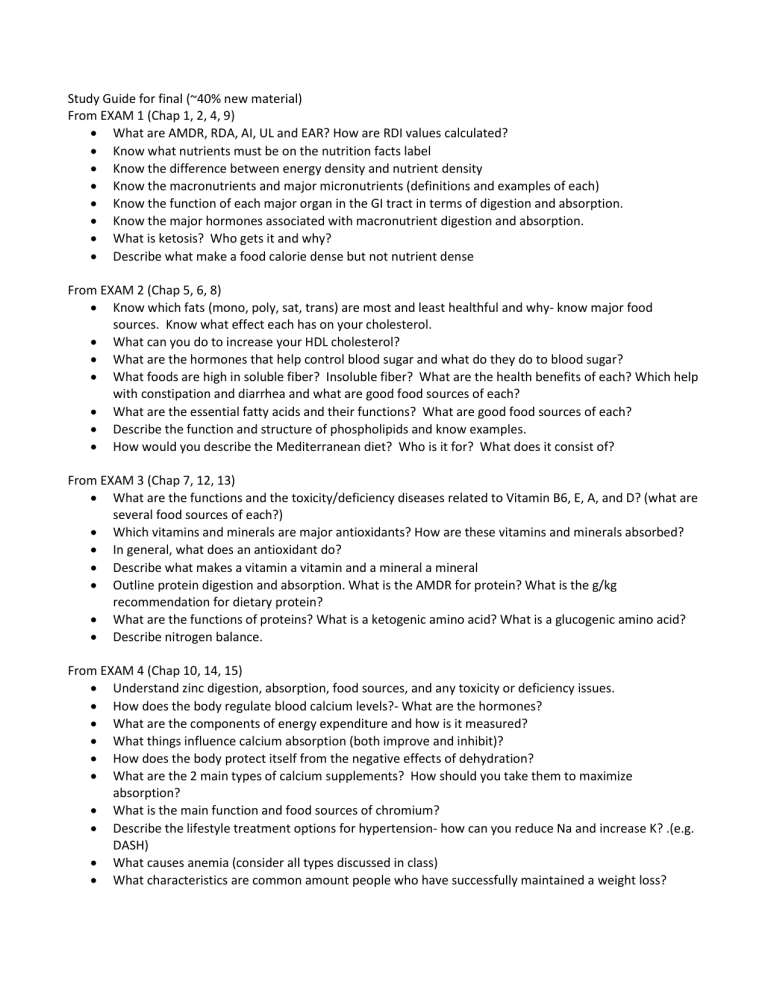
Study Guide for final (~40% new material)
From EXAM 1 (Chap 1, 2, 4, 9)
What are AMDR, RDA, AI, UL and EAR? How are RDI values calculated?
Know what nutrients must be on the nutrition facts label
Know the difference between energy density and nutrient density
Know the macronutrients and major micronutrients (definitions and examples of each)
Know the function of each major organ in the GI tract in terms of digestion and absorption.
Know the major hormones associated with macronutrient digestion and absorption.
What is ketosis? Who gets it and why?
Describe what make a food calorie dense but not nutrient dense
From EXAM 2 (Chap 5, 6, 8)
Know which fats (mono, poly, sat, trans) are most and least healthful and why- know major food sources. Know what effect each has on your cholesterol.
What can you do to increase your HDL cholesterol?
What are the hormones that help control blood sugar and what do they do to blood sugar?
What foods are high in soluble fiber? Insoluble fiber? What are the health benefits of each? Which help with constipation and diarrhea and what are good food sources of each?
What are the essential fatty acids and their functions? What are good food sources of each?
Describe the function and structure of phospholipids and know examples.
How would you describe the Mediterranean diet? Who is it for? What does it consist of?
From EXAM 3 (Chap 7, 12, 13)
What are the functions and the toxicity/deficiency diseases related to Vitamin B6, E, A, and D? (what are several food sources of each?)
Which vitamins and minerals are major antioxidants? How are these vitamins and minerals absorbed?
In general, what does an antioxidant do?
Describe what makes a vitamin a vitamin and a mineral a mineral
Outline protein digestion and absorption. What is the AMDR for protein? What is the g/kg recommendation for dietary protein?
What are the functions of proteins? What is a ketogenic amino acid? What is a glucogenic amino acid?
Describe nitrogen balance.
From EXAM 4 (Chap 10, 14, 15)
Understand zinc digestion, absorption, food sources, and any toxicity or deficiency issues.
How does the body regulate blood calcium levels?- What are the hormones?
What are the components of energy expenditure and how is it measured?
What things influence calcium absorption (both improve and inhibit)?
How does the body protect itself from the negative effects of dehydration?
What are the 2 main types of calcium supplements? How should you take them to maximize absorption?
What is the main function and food sources of chromium?
Describe the lifestyle treatment options for hypertension- how can you reduce Na and increase K? .(e.g.
DASH)
What causes anemia (consider all types discussed in class)
What characteristics are common amount people who have successfully maintained a weight loss?
NEW MATERIAL (Chap 16, 17, 18, 11)
What is considered a successful pregnancy and what factors are predictive of a successful pregnancy?
What is meant by “critical periods” in what trimesters do zygote, embryos and fetuses hit major milestones, and what does it mean in terms of importance of nutrition?
What is the optimal weight gain during pregnancy for adult women? When does she need the most calories?
Describe the special nutritional needs of lactating and pregnant women, summarize factors that put them at risk for the common nutritional issues seen during pregnancy and lactation and how to avoid deficiencies. (think of both macro and micro nutrients)
List substances and practices to avoid during pregnancy and lactation
Describe the hormones involved in breastfeeding.
Describe normal growth and development during infancy, childhood and adolescence and how it is tracked. Know how a child is classified as overweight and obese under age 2.
Compare and contrast the calorie and nutrient needs and habits of infants, children and adolescents.
Compare and contrast the nutritional qualities of human milk, infant formula, and cow’s milk. How much fat, cho and pro do babies need? Know different types of breast milk.
Explain the rationale for the delay in feeding infants solid foods until 4 to 6 months of age and the general guidelines to follow when introducing solids.
Describe how physical and physiological changes that occur during adulthood affect nutrition needs.
Identify nutrition-related health issues of the adult years and describe the prevention and treatment of these health problems.
Summarize the recommendations to promote a long, healthy life.
What community nutrition services are available for older persons?
Explain the benefits of physical activity for the elderly.
Describe the energy sources for muscles and human performance for different sports.
Describe main nutrition concepts used when designing diet plans for athletes e.g. what to eat/drink before, during and after a workout.
Know the hydration recommendations for athletes
Describe the fluid needs of athletes and how to avoid dehydration and hyponatremia- know the role sports drinks play.
Describe how the composition of food eaten before, during and after exercise training sessions can affect performance.
How many grams of protein (in g/kg) do athletes need?
Explain the role of ergogenic aids and describe their effect on athletic performance (only those discussed in class).
